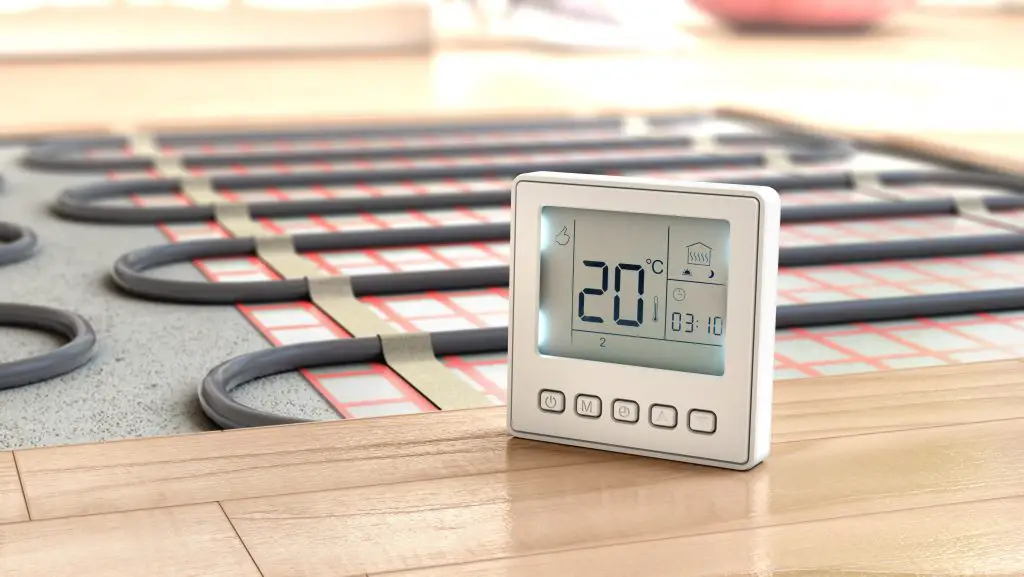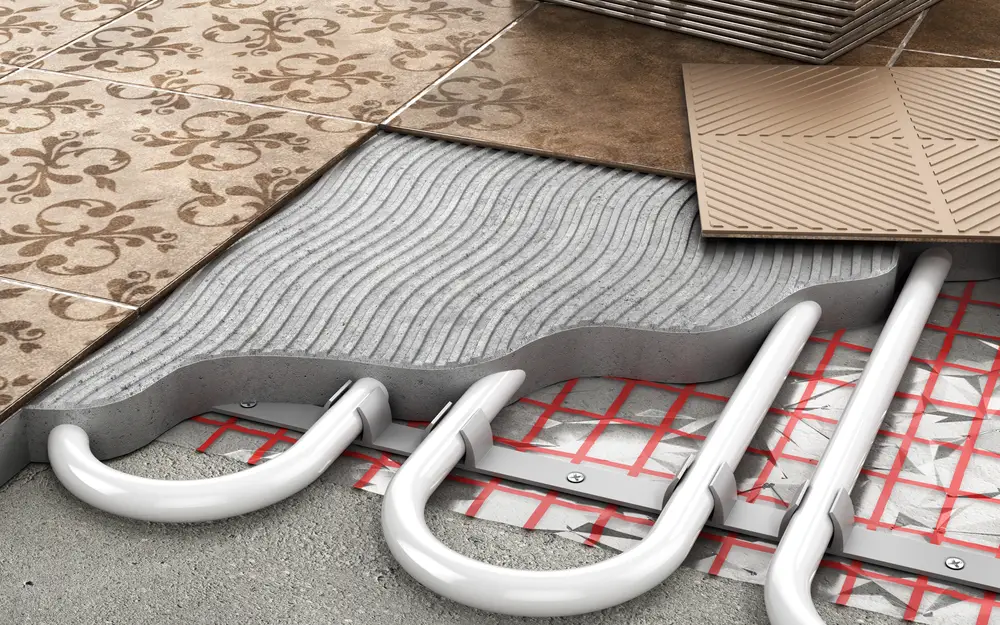Underfloor heating in a kitchen allows you to enjoy a toasty warm floor whilst cooking and entertaining. There are some key kitchen underfloor heating considerations to make when adding this heating system to a kitchen design, including whether you can place kitchen units on top of heated floors.
Underfloor heating should not be placed under kitchen units. The use of underfloor heating under kitchen units could lead to thermal blockage, as the heat generated at that spot would not be properly distributed. Foods are more likely to go off when heated from below.
Water underfloor heating systems can also be used in kitchens, as long as the underfloor pipe network is not situated under or too close to the fixed kitchen units. This would help prevent temperature rise in that particular area and energy waste.

What effect does Underfloor Heating have on Kitchen Units?
Usually, this will not affect the kitchen units at all as there is an air barrier between the units created by the small cap of the bottom shelf and the floor. This means that even when the heating has been set to its maximum temperature there is little actual heat being pushed into the kitchen cabinets. Allowing you to comfortably store anything in the units without having to stress about the heat causing food to go sour.
This additionally means that you can easily and comfortably move the units around the kitchen without having to stress, usually allowing people to easily adjust. As kitchen units tend to change with the styles of the house, the needs of the family living there, and the whims of those who use them having the kitchen units unaffected by the heating is a great help.
Allowing families to remove the units, install new ones, or move them as needed is a great way of ensuring someone can easily love their homes. This also means that if the units are moved around, shifted, or adapted the kitchen will stay just as warm and comfortable as any other room in the home that enjoys having access to the always comfortable heated floors.
What Effect does Underfloor Heating have on Foods in the Kitchen?
Underfloor heating should not be placed under cupboards if there is no adequate insulation below the base of the cupboard. Without proper insulation, the heat generated below the base of the cupboard may not be too suitable for the food items stored there.
Various food items have a temperature range at which they are stored. Canned foods are to be stored between the range of 50F(10°C) to 70F(21°C), which is far below the maximum temperature (29°C) of underfloor heating systems. High temperatures decreases the shelf-life of canned foods, as it favors the proliferation of the edible bacteria in them, it also causes the food to react with the insides of the can.
Other food items such as milk, grains, fruits should also be kept at low temperatures stated above.

Does Underfloor Heating Affect Kitchen Appliances such as Fridges and Freezers?
Placing freezers directly over underfloor heating systems does not just affect the freezer, it also causes damage to the floor. Although the refrigerator was made to function under ambient air temperature with the compressor underneath, the temperature increase would make the fridge’s compressor overwork which could lead to overheating, and subsequently, reduce the service life of the fridge.
In cases whereby the underfloor heating system is placed across the entire length of the floor, the fridge to be placed in the kitchen should be placed on a platform, with a ground clearance from the floor to enable proper heat distribution and airflow. An insulation layer can also be added below the fridge to prevent heat from getting to the base of the fridge.
Is Water-based or Electric Underfloor Heating more suited to a Kitchen?
Before installing underfloor heating, the fixed kitchen units must first be taken into consideration. Electric underfloor heating is more suitable for kitchens, as it is installed around kitchen units in order prevent to thermal blockage and waste of the heat generated. Water underfloor heating could also be used in kitchens, but the underfloor pipes would also have to be installed away from the kitchen units.
In cases whereby the kitchen could be renovated in the nearest future and to prevent having uneven distribution of heat across the floors, underfloor heating would need to be installed across the whole floor. Before putting the kitchen units back into place, the installer would need to add layers of insulation over the designated areas for the kitchen units.
Flooring Choices for Kitchen Underfloor Heating
The best type of flooring for kitchens would be one that can be cleaned easily, distribute the heat properly, is not slippery, and is wear-resistant. Tiles and concrete floors are better suited for kitchens. Engineered wood may not be too suitable for kitchen flooring, as engineered wood may begin to absorb moisture over time due to water spillage, which could spell doom for the underfloor heating system.
Whilst they are not 100% waterproof, laminate and vinyl flooring are often used for kitchen flooring.

How do things on top of heating spots change the heating?
Having large spaces taking up the heated floor will not affect the overall heating of the home, as the amount of open space should always be enough to heat the home. The things on top of the floor only become a problem of more than 60% of the available floor space has been used up.
The heated flooring might still be able to heat the home you are in, but the effectiveness will drastically decrease the more overall space in the home is covered by something close to the ground. This is why you should not have units that hug the ground when you have underfloor heating, as allowing more floors to be open to the air flowing through your home will allow it to be heated much quicker.
Appliances like washers, freezers, TVs, or others are not large enough to cause significant changes in the effects of your underfloor heating system. The worst thing you can keep on top of a heated floor is a giant thick carpet that covers the floor from one wall to the other, this created nothing other than a fully insulated system.
What does heated flooring do to a kitchen?
Underfloor heating systems present the following benefits. They include:
- Comfort: Underfloor heating systems make kitchens floors more comfortable to walk-on on colder days when you want to make large meals and would need to stay in the kitchen for longer periods.
- Space: Unlike radiators which take up ample space, underfloor heating systems are practically invisible upon installation.
- Mites and Mold control: It is important to note that the heated flooring stops mold and mites from being spread throughout the home.
This heating system also has some underlying disadvantages, some of which include the following:
- Food Spoilage: In cases whereby underfloor heating systems are installed under kitchen units where food items are stored, it could lead to food spoilage. Canned foods in particular are incompatible with heat as it reduces their shelf life.
- Kitchen Redesign: Kitchens with underfloor heating pose a huge task when it comes to renovation. Kitchen units cannot just be moved about, as there would be an uneven distribution of heat since the area under that furniture does not contain underfloor heating. The available space for them to be installed would have to be properly insulated due to the underfloor heating installed there.

Why should you put underfloor heating everywhere?
Heated flooring should be installed equally throughout the home to ensure that when things are moved, adjusted, or modified there is no lack of heating in those locations. Having a completely heated home will therefore mean that even if the home is completely revamped and improved upon there is no need to rip up the floors to add onto the heated flooring system.
This also means that the house is properly future-proofed, as it can now comfortably and easily be changed or updated without needing to be significantly changed. Electric underfloor heating systems are not as futureproof as water-based systems, this is because the control units of electric systems are intricately linked with the panels that have been installed in your home.
However, if you have your entire home properly piped with a water-based system then you can upgrade it as technology keeps advancing. As the pipes will usually be the same, you can upgrade the control unit, the thermostat, the heating element, and the pressure system to ensure that it stays entirely functional and capable.
Conclusion – Kitchen Units and Underfloor Heating
Underfloor heating systems should not be placed below kitchen units, and in situations whereby the whole floor is fitted with underfloor heating, it should have proper insulation or ground clearance to ensure the heat does not seep into the base of the furniture.
An electric underfloor heating system is more suitable for kitchens. It is much easier to install and maneuver fixed units which in turn helps to save the cost of electricity needed to run the underground heating for the whole floor.
The choice of floors for kitchens should be one that can be cleaned easily, wear-resistant, and not slippery.
Lots more Underfloor Heating Information Here
- What Depth is Required for Underfloor Heating?
- Turning on Underfloor Heating for the First Time – How Long to Wait?
- Can you lay Vinyl flooring over underfloor heating?
- Do Tiles Crack With Underfloor Heating?
- Can You Heat a Whole House With Underfloor Heating?
- Can You Have Underfloor Heating Upstairs?
- Will Underfloor Heating Raise My Floor? – Underfloor Heating Layers Explained
- Can I put furniture on top of underfloor heating?
- How Do I Know If My Underfloor Heating is Leaking?
- Can You Combine Underfloor Heating With a Ground Source Heat Pump?
- Is Underfloor Heating Safe?
- Does Underfloor Heating Add Value to a Property?
- Can you have Wooden Floors with Underfloor Heating?
- Can Underfloor Heating Cause a Fire?
- What temperature should Underfloor Heating be set at?
- Can I Put a Rug Over Underfloor Heating?
- How Long Does it Take for Underfloor Heating to Warm Up?
- Why is my Underfloor Heating Noisy?
- Why is my Underfloor Heating Patchy?
- How do I know if My Underfloor Heating is Working? – Common Problems & Fixes
- What can go wrong with underfloor heating?
- Can you Combine Underfloor Heating with an Air Source Heat Pump?
- Do you keep underfloor heating on all the time?
- Does Underfloor Heating work with Smart Thermostats?
- Kitchen Underfloor Heating – Should Underfloor Heating go Under Kitchen Units?
- How much energy does Underfloor Heating use?
- Underfloor Heating in Summer and Winter
- Lifespan of Underfloor Heating
